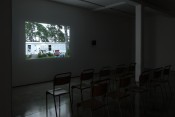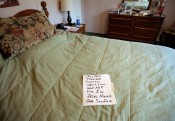Carlton Turner is an inmate on death row in Huntsville, Texas. In 2006 he is contacted by Norwegian artist Kjersti Andvig: Will he collaborate with her? They correspond. Carlton finds Kjersti intellectually stimulating. Together, they design an installation, a prison cell decorated with knitting. Carlton chooses gang symbols for the walls. Kjersti visits Carlton a number of times, and he discovers that Kjersti is very pretty. Kjersti wants Carlton to love her. Somewhere along the line, video artist Lars Laumann hears of their collaboration and starts to investigate it. Kjersti talks. She visits Carlton’s favorite death-metal radio station. The DJs believe in the resurrection of the dead: Soon Carlton will be able to hear whatever music he likes via the ether, they chuckle. Kjersti moves into a trailer owned by a woman named Eileen, who believes in life everlasting too. Carlton is to be executed. Kjersti and Carlton get drunk together via a contraband cell phone. Kjersti chances upon filmmaker James. He’s making a film about prisoners’ “last suppers.” He gives Kjersti a lift to the death chamber. Lo! Jesus saves! As Eileen has predicted, Carlton gets a stay of execution. But he is soon returned to the death chamber. Outside the jail, Kjersti and Eileen’s T-shirts proclaim that Carlton shall live and not die. He receives a lethal injection. Kjersti gets to touch Carlton for the first time soon after he is declared dead. The next day, Kjersti spends four hours with Carlton’s body. He’s a bit cold from the fridge. Back at the trailer, Kjersti shows Lars her mortuary snapshots. Kjersti and Eileen left a Bible verse printed on fabric on his chest – which verse, Kjersti can’t remember. She starts leaving a key on the doorstep in case Carlton turns up. She remains in denial for several months.
Then Laumann’s fifty-eight-minute, looped documentary video Shut up Child, This Ain’t Bingo, 2009, begins again, leaving viewers to puzzle over the substance and import of it all. In fact, the above account lends the narrative a false coherence: Laumann’s edit obscures both the historical sequence of events and the shooting order of the footage; the work seems engineered without a designated start or finish. Further, its subject (“death row correspondence-turned-romance”) seems so much like documentary boilerplate, and the filmmaker’s access to the imprisoned subject so open and easy, that one’s suspicions are aroused. Most unaccountable of all is everyone’s (including Turner’s) bizarre insouciance in the face of the impending execution. Surely this must be a fabrication?
Internet research suggests the story is factual: a real prisoner, a real artist, some kind of relationship between them, and (on July 10, 2008) a real execution. Also, a real crime: At age nineteen and (in his version) after years of abuse, Turner shot his adoptive parents. But Laumann’s film suppresses this, and it’s a key omission. Like his 2008 work Berlinmuren, a study of a woman “married to” the Berlin Wall, this is a study in dissociation. Such denial is not just expressed by Andvig, who acknowledges her pathological disavowal in a brief voice-over. It’s in the joking DJs, or Turner smiling and chuckling placidly at the camera. It spreads to the viewer too: One realizes one is watching with mere curiosity a twenty-nine-year-old who is about to be slaughtered. No guilt, pain, anxiety, or fear: The documentary’s style mimics a kind of opiate-induced detachment. It’s a valid aesthetic exercise, for sure, but also a risky one, in which – contrary to the film’s title – the issue of life or death shrinks, perplexingly, to the status of a game.
Lars Laumann: Shut up Child, This Ain’t Bingo showed at Maureen Paley, London, between June 1 – August 16 2009
Text © Rachel Withers & Artforum International Magazine, Inc. 2009. Images © Lars Laumann; contact Maureen Paley Gallery for details.

